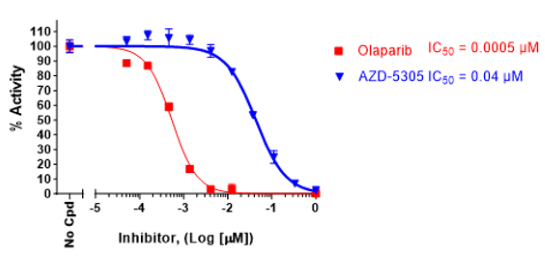PARP2 Colorimetric Assay Kit
The PARP2 Colorimetric Assay Kit is designed to measure PARP2 (poly-(ADP-ribose) polymerase 2) activity for screening and profiling applications. The PARP2 assay kit comes in a convenient 96-well format, with enough purified PARP2 enzyme (amino acids 2-583), reaction substrates and PARP assay buffer for 100 enzyme reactions.

Figure 1. PARP2 Colorimetric Assay Kit schematic.
Histone proteins are coated on a 96-well plate. Next, a biotinylated NAD+ mix (termed PARP Substrate Mixture) is incubated with the PARP2 enzyme and an activated DNA template in an optimized assay buffer. The plate is then treated with streptavidin-HRP followed by addition of the colorimetric HRP Substrate which generates a colored solution. The signal generated is proportional to PARP2 activity
Need us to run inhibitor screens or profile your compounds against PARP2? Check out our PARP/PARPTrap™ Screening Services or DNA Replication and Repair Screening Services.
This product has been cited 12 times.
- 1x PBS (Phosphate Buffer Saline) Buffer
- PBST Buffer (1x PBS, containing 0.05% Tween-20)
- UV/Vis spectrophotometer microplate reader capable of reading absorbance at λ=450 nm*
- 2 M sulfuric acid (aqueous)
- Adjustable micropipettor and sterile tips
- Orbital Shaker
*Alternately, a spectrophotometer reading at 650 nm may be used, but sensitivity of the assay will be greatly reduced.
| Catalog # | Name | Amount | Storage |
| 80502 | PARP2, GST-Tag* | 3 µg | -80°C |
| 52029 | 5x Histone Mixture | 1 ml | -80°C |
| 78366 | PARP Substrate Mixture 1 | 2 x 250 µl | -80°C |
| 80602 | 10x PARP Assay Buffer | 1 ml | -20°C |
| 79743 | Blocking Buffer 3 | 25 ml | +4°C |
| 80605 | Activated DNA | 20 µl | -80°C |
| 80611 | Streptavidin-HRP | 100 µl | +4°C |
| 79651 | Colorimetric HRP Substrate | 10 ml | +4°C |
| 0.5 M DTT | 200 µl | -20°C | |
| 79964 | 96-well transparent plate | 1 | Room Temp |
*The concentration of the protein is lot-specific and will be indicated on the tube
PARP2, also known as poly-(ADP-ribose) polymerase 2 or NAD+ ADP-ribosyltransferase 2, is part of the PARP family. ADP ribosylation, which is the addition of an ADP-ribose to a protein, is a reversible post-translational modification of proteins mostly involved in the DNA Damage Response (DDR) pathway. Poly-ADP-ribosylation (termed PARylation) is the addition of linear or branched chains of ADP-ribose. PARP2 participates in DNA repair (only 10% of the PARP activity is due to PARP2), but also in oxidative stress and mitochondrial fragmentation. Dysfunction of the DDR and oxidative stress pathways can lead to oncogenesis. Genetic ablation of PARP2 has indicated roles of PARP2 in adipogenesis, spermatogenesis and thymocyte survival. It is also a co-factor of nuclear receptors like ER (estrogen receptor) and PPAR (peroxisome proliferator-activated receptors). PARP2 is overexpressed in prostate cancer (PCa) and may contribute to the disease through the FOXA1 (forkhead box protein A1)/AR pathway. PARP inhibitors have been used in cancer treatment with success, with the clinically approved inhibitors targeting both PARP1 and PARP2. Further understanding of the molecular pathways involving PARP2, and its contribution to disease, will continue to pave the way for new therapies for PARP2-linked diseases.
Brown, J.A., Marala, R.B. 2002. J. Pharmacol. Toxicol. Methods 47:137-41.


